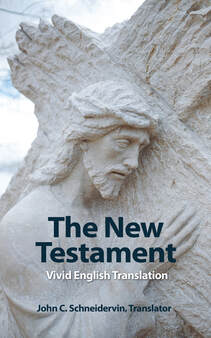What Do You Need To Know About The Old Testament?
First of all, you need to know who and what the Old Testament is about.
Who is the Old Testament about? The answer to this question is given already in its very first verse: “In the beginning God created the heavens and the earth.” (Genesis 1:1) The Old Testament is about God.
And what is the Old Testament about? What did the apostles preach about to the multitudes on Pentecost? The mighty deeds of God (see Acts 2:11). So also the Old Testament is about the mighty deeds of God that he did to bring about the salvation of mankind.
So what do you look for? As you read the Old Testament look for it to tell you about God and what he did during the Old Testament era of history to carry out his plan of salvation for you and all of mankind.
Who is the key person of the Old Testament? To learn who is the key person of the Old Testament, you must look at what our Lord and Savior Jesus Christ said about the Old Testament. He said in Luke 24:44, “These are my words which I spoke to you while I was still with you, that all the things that had been written about me in the Law of Moses and the Prophets and the Psalms must be fulfilled.” The Law o Moses and the Prophets and the Psalms made up the Old Testament Scriptures. The Law o Moses and the Prophets and the Psalms was the name, the title, for the Old Testament Scriptures. Jesus said those Old Testament Scriptures had been written about him. Jesus also said in John 5:39, “Search the Scriptures, because you think you have eternal life in them; and these are the Scriptures that testify about me.” So who is the key person whom the Old Testament is about? According to our Lord Jesus Christ, he is the key person of the Old Testament Scriptures.
Since the Old Testament Scriptures had been written about the Lord Jesus Christ, the key person of the Old Testament whom you need to look for is Jesus Christ, the Messiah, the Savior of mankind. So when you are reading and studying the Old Testament, you should be looking for information that tells you about Jesus Christ the Savior. You find him in such verses as Genesis 3:15 & 12:3 (which are in The Law of Moses), Isaiah 53 (which is a big part of The Prophets), and Psalm 22 (which is one of The Psalms). And in the process of telling you about the Messiah and Savior who was to come, the Old Testament reveals to you what was God’s plan of salvation for you and all mankind. In reading the Old Testament if you miss finding the good news about Jesus Christ and God’s plan of salvation, you miss the whole point of the Old Testament.
How, then, might the Old Testament be summarized? It is about God’s plan of salvation that centers in Jesus Christ the Savior of all people. This is the first information you need to know about the Old Testament. The Old Testament pointed ahead to the Messiah Jesus Christ who was to come, while the New Testament points back to him who did come.
The next point of information for you to know is how the Old Testament was written. Like the New Testament, the Old Testament was inspired by God and was written by men. This statement is in accordance with 2 Peter 2:21 that states, “Men spoke from God while being carried along by the Holy Spirit.” God the Holy Spirit chose certain men to do the task of writing his Holy Scriptures. He used their talents and writing styles to write exactly what he desired them to write. Men were the writers of the Old Testament; the Holy Spirit was its author. For more details about how the Old Testament was written, see on Christian Inconnect the Bible Study entitled “What Is The Truth About The Bible?”
Another important point you should know about the Old Testament is that it is Scripture, God’s authoritative Word. Our Lord and Savior Jesus Christ referred to the Old Testament as a complete body of divinely authoritative writings, which he recognized as, and called, Scripture. In John 10:35 he quoted Psalm 82:6 and considered it together with the rest of the Old Testament as “Scripture”, and said, “The Scripture cannot be broken.” He also referred to the Old Testament as Scripture in Matthew 21:42, Matthew 22:29, and Mark 14:49. Jesus not only recognized that the Scriptures as a whole unit held divine authority, he also recognized that even its very letters and words were authoritative. For example, in Luke 16:17 he recognized that even a part of a letter of the Old Testament was authoritative. He said, “It is easier for heaven and earth to pass away than for one stroke of a letter of the Law to become invalid.” And in Psalm 82:6, mentioned above, he keyed on the word “gods” as being authoritative.
There are two verses that give an indication of what Jesus considered to be part of the divinely authoritative Old Testament Scriptures. First, in Luke 24:44 Jesus told his disciples, “These are my words which I spoke to you while I was still with you, that all the things that had been written about me in the Law of Moses and the Prophets and the Psalms must be fulfilled.” In this verse Jesus recognized the Old Testament Scriptures consisted of three divisions – the Law of Moses, the Prophets, and the Psalms. The Law of Moses was the Pentateuch, or The Five Books of Moses. The Prophets included the historical books and the books of the prophets. The Book of Psalms was the first of the books called The Sacred Writings. These three divisions embraced the 39 books of the Old Testament from Genesis to Malachi as they are listed in the Protestant Bibles.
The second passage that gives an indication of what books Jesus understood to be included in the Old Testament Scriptures is Luke 11:49b-51, “. . . some they will kill and some of them they will persecute, in order that the blood of all the prophets that has been shed from the foundation of the world may be required of this generation, from the blood of Abel to the blood of Zechariah, who perished between the altar and the house of God.” Here Jesus spoke of the murders of all of God’s Old Testament prophets beginning with Abel and ending with Zechariah. The murder of Abel was written in Genesis 4. The murder of the prophet Zechariah was written in 2 Chronicles 24. According to the Hebrew Masoretic Text of the Old Testament, Genesis was its first book and 2 Chronicles was its last book. Thus in recounting the murders of all the Old Testament prophets Jesus indicated what was the complete set of books of the Old Testament, which, when arranged in the order of the familiar Protestant Bible, are Genesis to Malachi.
Canon:
The English term “canon” is derived from the Greek word “kanon” that meant a straight reed, staff, or ruler. It was a word used for measurement. It denoted what was recognized as the accepted standard and rule. As applied to the books of the Bible, and in this discussion the books particularly of the Old Testament, canon meant those Old Testament books that measured up to the standard of divine inspiration and authority.
Luke 24:44 and Luke 11:49b-51 indicate what books of the Old Testament the Lord Jesus accepted as the canon of the divinely inspired authoritative Old Testament Scriptures. That set of 39 books has been accepted as the canonical writings of the Old Testament, or what is called the canon.
The Old Testament canon, as explained above, consists of three divisions or parts. Those three divisions together with their respective books as listed in the Hebrew Masoretic Text are as follows:
The Law Of Moses: (also known as The Law, the Pentateuch, and The Five Books of Moses)
Genesis
Exodus
Leviticus
Numbers
Deuteronomy
The Prophets:
Joshua
Judges
1 Samuel
2 Samuel
1 Kings
2 Kings
Isaiah
Jeremiah
Ezekiel
Hosea
Joel
Amos
Obadiah
Jonah
Micah
Nahum
Habakkuk
Zephaniah
Haggai
Zechariah
Malachi
The Sacred Writings: (of which the Psalms is the first)
Psalms
Job
Proverbs
Ruth
Song Of Solomon
Ecclesiastes
Lamentations
Esther
Daniel
Ezra
Nehemiah
1 Chronicles
2 Chronicles
Note: On its Bible Studies page Christian Inconnect will follow the listing of Old Testament books according to the English Protestant Bible.
An interesting bit of history about the Old Testament for your information: Before the development of the book with its covers, pages, and binding, the 39 canonical books of the Old Testament were written on scrolls about 20 feet long. The scrolls were made of the skins of lambs or goats, which were called parchments, or they were made of papyrus. Shorter writings of several authors were written on the same scroll, as was done with the 12 shorter books of the minor prophets of the Old Testament. The longer writings of Moses were written on 5 scrolls, each of which became a separate book of the Old Testament. In all 24 scrolls were used to contain the 39 books of the Old Testament. Those 24 scrolls of the Old Testament were stored by the Jews in a cabinet that was made with 24 compartments. This manner of combining the 39 books of the Old Testament into 24 scrolls led to a division of the Old Testament into 24 books. The Jewish writer Josephus, who wrote during the latter part of the first century after Christ, mentioned an Old Testament that consisted of 22 books. This total of 22 books apparently was the result of combining the Book of Ruth with the Book of Judges and the Book of Lamentations with the Book of Jeremiah.
The Apocrypha:
The Roman Catholic Church added 14 other books to the Old Testament canon that it considered of equal authority with the books of the Old Testament.
Apocrypha is a term derived from a Greek word that means “hidden”. It came to be identified with 14 books that Palestinian Jews considered “outside writings” that were not included in their Old Testament canon. Hellenistic, Greek speaking, Jews, however, preserved the apocryphal books. During the intertestamental period, that is the time between the writing of the Old and New Testaments, the Hebrew writings of the Jews were collected in Alexandria, Egypt. Those writings included the canonical books of the Old Testament and the apocryphal books as well. Both the canonical books and non-canonical Apocrypha were translated starting in the 3rd century B. C. into a Greek translation called the Septuagint (LXX) that is thought to have been completed in the first half of the 2nd century B. C. This Greek translation was used widely in Christian circles. During the period of the Reformation scholars used the term Apocrypha to denote the uncanonical books included in the Roman Catholic Vulgate.
Date of the Old Testament:
The Old Testament was written starting with Moses, who wrote during the time of the exodus from 1440-1400 B.C. The Old Testament was closed with the Book of Malachi around 400 B.C. So the Old Testament was written over a period of about 1,000 years.
Theme Of The Old Testament:
God’s Plan Of Salvation That Centers In Jesus Christ The Savior Of All People
Return to the Overviews Of The Old & New Testaments page





